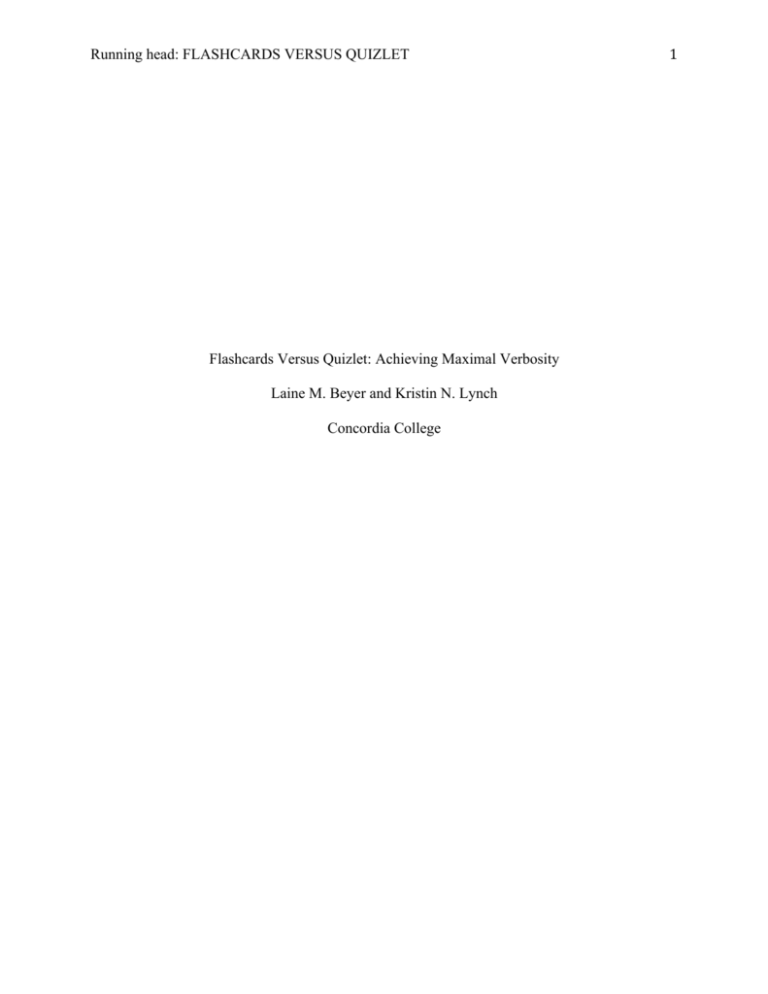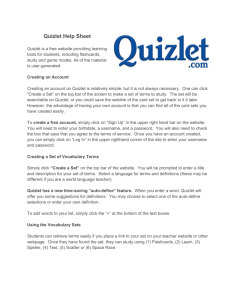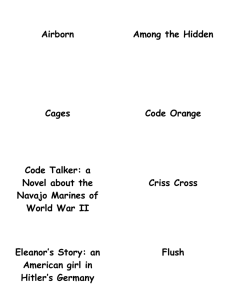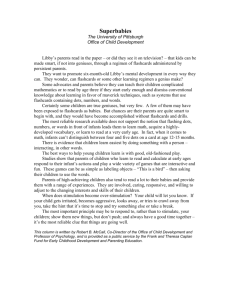Running head: FLASHCARDS VERSUS QUIZLET 1 Flashcards
advertisement

Running head: FLASHCARDS VERSUS QUIZLET Flashcards Versus Quizlet: Achieving Maximal Verbosity Laine M. Beyer and Kristin N. Lynch Concordia College 1 2 FLASHCARDS VERSUS QUIZLET Abstract Vocabulary leads to communication; it is a vital part of language learning. Technology has become a more popular means than ever for vocabulary acquisition. This study examines the effectiveness of electronic flashcards versus a more traditional flashcard method. Participants were divided into two groups, randomly assigned a method and after a short study period, assessed on their retention of the terms. While our study did not show significance, it indicated a small effect size which leads us to believe our research has taken a step in the right direction of the filling the research gap between vocabulary acquisition and technology. It provides practical applications for the classroom such as motivational factors and self-pacing. This area of research has a lot of potential and the study could be replicated with a larger sample size to obtain a better picture of the reality of the effect of technology on vocabulary acquisition. FLASHCARDS VERSUS QUIZLET 3 Flashcards Versus Quizlet: Achieving Maximal Verbosity Technology has become a vital part of our society today. It is a daily part of life for adults and children alike. The benefits far outweigh the negatives by helping to connect cultures and create a global world. This is equally evident in the advantages it brings to the classroom. Students are able to easily communicate with pen pals, access authentic material, and experience “real-life situations” through media and online resources. It also allows them to dialogue with native speakers and learn how to apply their knowledge to everyday life. Research has shown that technology is self-motivating and adequately captures the essentials of language learning as summarized by the American Council on the Teaching of Foreign Languages: communication, cultures, connections, comparisons, and communities (Yang & Chen, 2007). Motivation is a vital factor in language learning. It can’t be denied that students are more motivated when fully engrossed and connected to the activity (Loucky, 2006) Collective class motivation can lead to a distinctive atmosphere. According to Doherty (2002), Demarais (2002), and Brandl (2002) (as cited in Ushida, 2005), many teachers believe motivation plays an important role in student success, and this has been explored in many studies (Ushida, 2005). A crucial study done by Gardner and Lambert in 1959, found that motivation was one of two key factors that influenced success in language learning (Gardner & Lambert, 1959). Their emphasis was on quantitative studies, and there has been a more recent movement to study motivation qualitatively (Ushida, 2005). These more recent qualitative studies have found many connections to the use of motivational technologies. With the evolution of technology the potential benefits for the classroom have increased making learning faster, accessible, and more successful for the students. This is due in part to FLASHCARDS VERSUS QUIZLET 4 the many options now at their fingertips: blogs, instant messenger, e-mail, online tests and quizzes, skype, mobile devices, iPods, and many more. The benefits these resources provide are numerous. Students are able to learn at their own pace and on the go. They can interact live with their instructors or the native speakers. Having a web presence encourages students to become more invested and thoughtful because they have a real audience. Learning should not end when a student leaves the classroom, and technology allows them to continue learning beyond (Sarica & Cavus, 2009). Although there has been research done on the effect of technology on learning in general, research on the use of technology, specifically digital flashcards, for vocabulary acquisition is greatly lacking (Zhu, Fung, & Wang, 2012). This gap needs to be filled because if technology is incorporated effectively allowing for individualized instruction and creativity, it can enhance motivation. Vocabulary acquisition is an essential part to language learning, and requires a large amount of vocabulary to be learned in a short amount of time (Groot, 2000). It is the first step of the acquisition process. It leads to better proficiency in communication, understanding of grammar concepts, and perspective on culture. It is directly connected with reading, listening, writing and speaking skills (Barcroft, 2004; Groot, 2000; Lan, 2013). Due to the need for research on vocabulary acquisition and retention through technology, this study explores the effect of technology on learning through a comparison of traditional and online flashcards. This study provides relevant research for educators because technology is ever present in the classroom setting today. It allows educators to present a number of options for learning vocabulary. Teachers are very aware of the learning styles and constantly working towards the best way to individualize instruction for students. Technology is beneficial to the students because it allows them to experience the word in more than one manner, improving their 5 FLASHCARDS VERSUS QUIZLET retention. It also allows for self-pacing (Loucky, 2006) This study shares pertinent information on methods in which students retain vocabulary. We also offer insights that participants shared concerning the effectiveness and amount of motivation provided by online flashcards. This research explores the use of technology in the classroom. We predicted that students who use Quizlet to learn 20 vocabulary words would perform better on the post-test than those who use traditional flashcards and activities to learn the same 20 terms because technology was integrated into their learning. Method Participants This study was conducted at a private college in the Midwestern region of the United States. Twenty-six students between the ages of 19 and 23 participated. The participants were from different language backgrounds. All were native speakers of Chinese and Portuguese. The participants were part of a college-readiness course prior to beginning their college experience. Twenty students were in ELL 111 and six were in 112. Design This study was an experimental research strategy using a between subject design. Students were randomly assigned to two groups to learn vocabulary. The independent variable was the method in which they acquired the vocabulary and the dependent variable was the test score on the post-test. An independent samples t-test was used to calculate the statistics and analyze the data. Procedure Before conducting our research, we explained our study and then obtained informed written consent indicating the willingness of the participants. As a first measure of study, a pre- 6 FLASHCARDS VERSUS QUIZLET test was administered in the form of a written examination with visual cues (see Appendices A and B). Visual cues were projected for 30 seconds each, totaling the pre-test time at 15 minutes. The purpose of the pre-test was to eliminate already known vocabulary and combat the ceiling effect. Both groups were given vocabulary and pictures (see Appendix C) to create their own flashcards. Group 1 created traditional flashcards, and Group 2 created their flashcards using the online flashcard creator, www.quizlet.com. Each group was given 30 minutes to do so. Group 1 used the flashcards to study with activities comparable to that of Quizlet. Group 2 studied the vocabulary at their own pace using the tools on the website. Both groups worked for 30 minutes. Following instruction, and after a brief break, students took a post-test through a written examination in the same format as the pre-test (see Appendices A & B). There were 20 terms; the test took ten minutes. Each correctly written term was worth one point; there was no partial scoring. The maximum possible score for the post-test was 20 points. The final piece entailed a focus group session with semi-structured life world interview questions (see Appendix D). The 26 participants were subdivided into six groups based on the method with which they were taught for a smaller interview experience. Each group had 30 minutes with one researcher. Results We predicted that students who used Quizlet to learn 20 vocabulary words would perform better on the post-test than those who used traditional flashcards and activities to learn the same 20 terms because technology was integrated into their learning. Our results found an equal variability in our sample population; therefore, an independent samples t-test with equal variances was performed. The null hypothesis could not be rejected, t(24) = -0.81, p = .212 (one-tailed), d = .32, a small effect size. As can be seen in Figure 1, the students who used Quizlet to learn 20 vocabulary words did not perform significantly better on 7 FLASHCARDS VERSUS QUIZLET the post-test, (M = 18.69, SD =2.72) than those who used flashcards to learn the same terms, (M = 17.85, SD = 2.58). Hence, our results failed to support our hypothesis. 20 19.5 Test SCores 19 18.5 18 17.5 17 16.5 16 15.5 Flashcards Quizlet Teaching Method Figure 1. Results from Post-Test: the means of the post-test scores from each teaching method. The error bars represent the 68% confidence interval. Discussion Our results failed to support our hypothesis that technology significantly enhances vocabulary acquisition. However, as seen in Figure 1, our data leads us to believe that with a larger sample size we would have seen a significance. This is further supported by our small effect size. A potential reason why our data didn’t support our hypothesis is that we were reaching the ceiling effect. Across the board the participants nearly acquired the terms within the time they were given in both groups. Had they been given more terms or less time, we might have seen different results. Despite the fact that we couldn’t support our hypothesis, our findings were in line with previous literature. Although minimally, we did find that learning was enriched by students who used Quizlet as opposed to flashcards. This can be seen when comparing the means of the post-test scores. FLASHCARDS VERSUS QUIZLET 8 As mentioned earlier, technology allows students to self-pace, and draws them in engaging them in learning the words in one than one manner (Loucky, 2006) It helps contribute to student success. Our findings did not show a significant difference; however, we saw firsthand, as the literature states, that technology was engaging and allowed for self-pacing. Following the post-test an interview session was conducted. Several themes arose from this session. All participants felt technology was vital to learning, but especially for fulfilling social needs. All were in agreement that technology is used all the time. Quizlet was found to be beneficial because, as participants stated, they could “choose the way” they wanted to learn. This supports the research we cited earlier from Loucky (2006). Participants found that using Quizlet was a new and exciting learning method, and definitely something they would use again in the future. Participants commented they could connect to using Quizlet because they feel “free and comfortable using computers in general,” so now they can link that to their learning. While the participants expressed many positive thoughts on the study, there were several limitations and shortcomings. Participants were not invested in the study. As they shared with us during the interview, they had a heavy workload on their minds and were also very distracted socially through their cell phones and close proximity to their friends. In an attempt to maintain high internal validity activities for the group using traditional flashcards were created similar to those of Quizlet allowing for student choice and requiring individual work. However, participants found it difficult to study alone and at that point some partner work began. As Quizlet only allowed for individual study, this occurrence lowered internal validity, but in the process raised external validity. Partner work is something that is very common and found in the regular classroom. FLASHCARDS VERSUS QUIZLET 9 An issue that may have lowered external validity is that we only studied college-bound students. The results can then be applied to other college bound students worldwide, but we can’t speak for the rest of the general population learning a second language. We suspect that if the study was replicated in the future with a larger sample size a greater significance could be discovered. It is worth exploring modifications to the study such as the number of terms or the time allotted for review. This study was done with a time restraint; therefore, a suggestion for future studies would be to collect data over an extended period of time to assess the benefits in the longevity. The implications of the study are many: technology allows self-pacing for the students, individualized instruction from the teachers, and motivation for learning. In conclusion, it is necessary for more research to be done on the benefits of vocabulary acquisition through technology. 10 FLASHCARDS VERSUS QUIZLET References Barcroft, J. (2004). Second language vocabulary acquisition: A lexical input processing approach. Foreign Language Annals, 37(2), 200-208. Brandl, K. (2002, March). Students' attitudes and perceptions of learning: A comparative study of a classroom-based and web-based language course. Taking language instruction online: Progress or demise? Paper presented at CALICO 2002, Davis, CA. Desmarais, L. (2002, March). Monitoring distance training. Paper presented at CALICO 2002, Davis, CA. Doherty, K.M. (2002). Students speak out. Education Week, 11 (35), 19-23. Gardner, R. C., & Lambert, W. E. (1959). Motivational variables in second-language acquisition. Canadian Journal of Psychology, 13 (4), 266-272. Groot, P. J. (2000). Computer assisted second language vocabulary acquisition. Language Learning & Technology, 4(1), 60-81. Lan, Y. (2013). The effect of technology-supported co-sharing on L2 vocabulary strategy development. Journal of Educational Technology & Society, 16(4), 1-16. Loucky, J. P. (2006). Maximizing vocabulary development by systematically using a depth of lexical processing taxonomy, CALL resources, and effective strategies. CALICO Journal, 23(2), 363-399. FLASHCARDS VERSUS QUIZLET 11 Sarica, G. N., & Cavus, N. (2009). New trends in 21st century english learning. Procedia Social and Behavioral Sciences, 1(1), 439-445. doi:10.1016/j.sbspro.2009.01.079 Ushida, E. (2005). The role of students' attitudes and motivation in second language learning in online language courses. CALICO Journal, 23(1), 49-78. Yang, S. C., & Chen, Y. (2007). Technology-enhanced language learning: A case study. Computers in Human Behavior, 23(1), 860-879. doi:10.1016/j.chb.2006.02.015 Zhu, Y., Fung, A. S., & Wang, H. (2012). Memorization effects of pronunciation and stroke order animation in digital flashcards. CALICO Journal, 29(3), 563-577. FLASHCARDS VERSUS QUIZLET Appendix A Sample of PowerPoint Slides Used for Pre-Test and Post-Test 12 13 FLASHCARDS VERSUS QUIZLET Appendix B Instrument Used to Collect Data for Pre-Test and Post-Test PLEASE DO NOT INCLUDE YOUR NAME As you see the images projected on the PowerPoint, write down the name of the bug. Each slide will be projected for 30 seconds. 1. __________________________ 11. __________________________ 2. __________________________ 12. __________________________ 3. __________________________ 13. __________________________ 4. __________________________ 14. __________________________ 5. __________________________ 15. __________________________ 6. __________________________ 16. __________________________ 7. __________________________ 17. __________________________ 8. __________________________ 18. __________________________ 9. __________________________ 19. __________________________ 10. __________________________ 20. ___________________________ FLASHCARDS VERSUS QUIZLET Appendix C Samples of Vocabulary Terms 14 15 FLASHCARDS VERSUS QUIZLET Appendix D Interview Questions 1. 2. 3. 4. 5. 6. 7. 8. Where are you from? Do you speak any other languages? What is your gender? What is age? How many years have you studied English? What course are you in 111/112? How do you study at home? With technology? How do you learn at school? What kinds of activities? With technology? How would you compare it to what you did today? Similar? Different? Fun? Boring? How much technology do you use? Is it important to you? How do you feel about technology and do you like using computers? For learning? Why? 9. Do you think the way you learned today (specify way) helped you learn more/less? Why? 10. Will you use the methods you used today in the future? Why or why not? 11. Other thoughts/opinions


